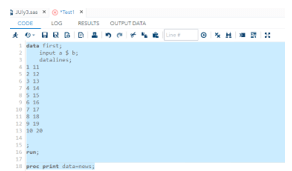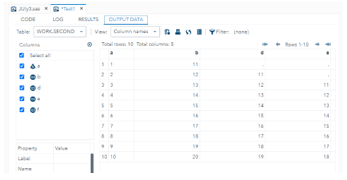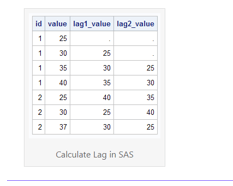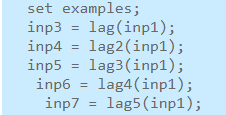Updated March 15, 2023

Introduction to SAS LAG Function
The SAS lag function is the type of function that can be used to compare the current value and the existing value, which is already there, and the new value of the predecessors to calculate the lag of the orders. The second order is used LAG2 function. Likewise, the third order will calculate the LAG3 function. LAG of the first order will use the grouping variable with other elements.
Overview of SAS Lag function
When the LAG function is used in the multiple ways for calculating the SAS lead in time series data. It is generally more required for lag and more lead of the one or more than variables measured. The time series or the longitudinal datas which considered more effect of the data challenging as well as data manipulation process tasks which tricks to easy effect for number of periods or rows and columns. The Lag of the first order will be looked at the data observation which denoted as last value and referred as the lag1_value. In the second order will denote as lag2_value of the data observations, lag function which helps to return the value of the character variable that has not been assigned to the length used in the parameter.
How to use SAS lag function?
LAG functions like LAG1, LAG2,….,LAGn which helps to return the values from the data queue LAG1 is retrieved and derived from the LAG and the LAGn function stores the values in the queue. For each occurrence the LAGn function of the program which generates the own queue values whereas the n denotes as the missing values length of the queue and initialized for removed and returned. Hence the missing values of the first occurrences and the remaining LAGn function executions the parameters begins to be called and appeared in the SAS function. Therefore the storing values of the bottom queue which helps to returning the values from top queue and also the function is executed conditionally stored and returned. Parameters of the LAGn is mainly called it as the array name and formed in the separate queue for maintaining the variable in array memory. If the function is compiled the SAS will allocate the memory in each and every data queues for holding the data bytes is 8 and the memory is needed for 8 times with 100 or 800 bytes. The memory limit of the LAG function which is based upon the memory which allocated to the SAS with different operating system environment. We accessed the subsequent rows and columns for the LAG function for comparing the current and previous or existing row values.
The following arguments like scalar_expressions, offset and default values for mandatory parameters and executed with fine set of arguments and declared in the offset integer numbers with number of rows. Mostly the offset is the optional parameters and the value is one similarly the default is defined with the offset of the first 3 consecutives rows and it cannot behind the lag function. The Partition by is another lag function syntax that helps to create the logical drive boundary datas for extensive dataset and almost it requires the calculations for smaller datasets. It depends upon the user and organization requirements the partition quarterly datas is computed like offset the partition also the optional argument.
Steps to Create SAS lag Function
- Navigate to the below URL,
- https://odamid-apse1-2.oda.sas.com/SASStudio/main?locale=en_GB&zone=GMT%252B05%253A30&ticket=ST-44711-XiooFbDlbokXgGqQ1gVZ-cas
3. Paste the below code for to create the sample dataset.
data first;
input a $ b;
datalines;
1 11
2 12
3 13
4 14
5 15
6 16
7 17
8 18
9 19
10 20
.
;
run
.
proc print data=news;data second;
set first;
d = lag(b);
e = lag2(b);
f = lag3(b);
run;
proc print data=second;- We can use the lag(), lag2(), lag3(),.. function for to compare the current value and followed or replaced by the another value.
SAS lag Function Data
The lag function is used to retrieve the data and lagged values for the some variable missing the data. It’s a technique for performing the data computations which across the observations using the LAGn function of nth-previous value of the function execution. Its to assume that the LAGn function which return the values of the existing values on the pre-conditional statement for assigning the new variable. There is no lag function for calculating the LEAD and SAS function for to sorting the order count the number of rows in the variable which sequence of table records. The function Lag is used in the data queue for returning the arguments and returns the values for calculating the missing values.
Another way to miss the data for accomplishing the task for LAG function which available in the data step. LAG also the variable name to perform the data observations and operations. To use the do and other loop functions which used the addition, subtraction and other default functions.
Useful computing the data observations with reference date and time functions and they used the PROC EXPAND stored procedure for executing the set of queries.
Example:
data examples;
input inp1 $ inp2;
datalines;
100 siva
101 raman
102 sivaraman
103 jack
104 ceasr
;
run;
proc print data=examp1;
data examp2;
set examples;
inp3 = lag(inp1);
inp4 = lag2(inp1);
inp5 = lag3(inp1);
inp6 = lag4(inp1);
inp7 = lag5(inp1);
run;
proc print data=examp2;
proc print data=examp2;Sample Ouptut:
- The above example first we need to create and set the datasets.
- Then using the datalines we can assign the inputs with two columns.
- We need to set the dataset example on the lag function.
4. We can perform the lag() function with n number of executions.
Conclusion
The lag() function is mainly used for to compare the current value of the predecessors in n number of type lag functions. Data queue for lag function which is on the direct sequence and consequence of the data constructions modulus function for each data observations on loopback with handling by groups.
Recommended Articles
This has been a guide to SAS LAG Function. Here we have discuss Introduction, overviews, How to useful SAS lag function, examples with code implementation. You can also go through our other suggested articles to learn more –








